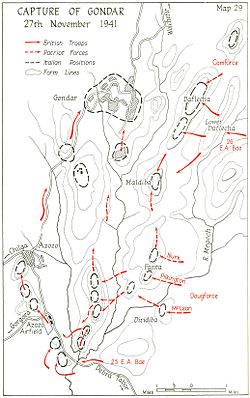
Back معركة غندر Arabic قوندار دؤیوشو AZB Slaget om Gondar Danish Schlacht von Gondar German Batalla de Gondar Spanish نبرد گوندار FA Bataille de Gondar French קרב גונדר HE Battaglia di Gondar Italian Slaget om Gondar NB
| Battle of Gondar | |||||||||
|---|---|---|---|---|---|---|---|---|---|
| Part of the East African Campaign of the Second World War | |||||||||
 British and Ethiopian movements against the Italians at Gondar | |||||||||
| |||||||||
| Belligerents | |||||||||
|
| |||||||||
| Commanders and leaders | |||||||||
|
|
| ||||||||
| Strength | |||||||||
|
41,000 70 guns 1 aircraft |
2 East African Infantry brigades Ethiopian Patriots Kenya Armoured Car Regiment South African Light Armoured Detachment[1] | ||||||||
| Casualties and losses | |||||||||
|
Italian: 407 killed (November 1941), 1,289 killed since June 1940 Ascari: 3,700 killed June–November 1941[2][page needed] Sick and wounded: 8,400 (Italian and Askari)[3] 22,000 prisoners (Italian and Askari) 1 aircraft[4] |
Final assault: 32 killed 182 wounded 6 missing 15 aircraft[4] | ||||||||
Gondar, city and district (woreda), in the Semien Gondar Zone of the Amhara Region, north of Tana Lake | |||||||||
The Battle of Gondar or Capture of Gondar was the last stand of the Italian forces in Italian East Africa during the Second World War. The battle took place in November 1941, during the East African Campaign. Gondar was the main town of Amhara in the mountains north of Lake Tana in Ethiopia, at an elevation of 7,000 ft (2,100 m) and had an Italian garrison of 40,000 men, commanded by Generale Guglielmo Nasi.
- ^ Playfair 2004, p. 320.
- ^ Angelo Del Boca, Gli italiani in Africa Orientale - 3. La caduta dell'Impero. 1,289 Italian officers and soldiers were killed in the Gondar sector from June 1940 to the end of the campaign, 407 of whom in November 1941.
- ^ Maravigna 1949, p. 191.
- ^ a b Playfair 2004, p. 321.
